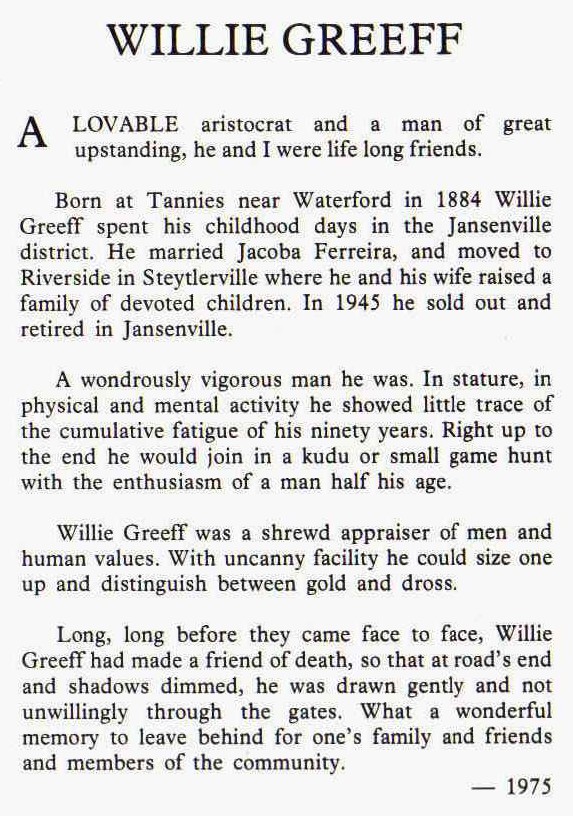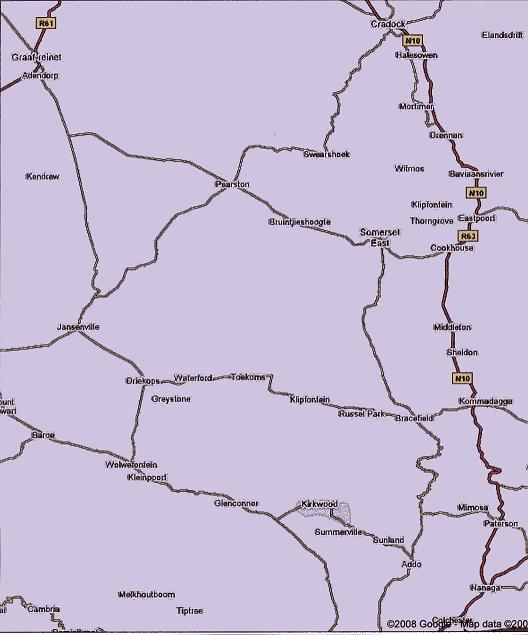|
Greeff
Contents 1. Greeff Genealogy - Hot News!
Greeff Genealogy
HOT NEWS!
This degree is a logical development that flowed naturally from the Greeff Farms Project. The Greeff Farms Project started when Francois Greeff put together a research team to gather more information about Greeff farms and their influence on the Greeff family. Francois approached Natanja, who was working on the Greeff Facebook Project at the time, and asked her if she would like to move from Facebook to the farms project, and she agreed. They asked Lee Greeff in Pretoria if she would like to join the farms project too, and she agreed. The structure of the project was such that Natanja would deal with the Cape Town archives and Deeds Office, and Lee would do the same in Pretoria, and Francois would co-ordinate and steer the project from London. Together, the three of them aim to publish a book with the title: Greeff Farms. In time, Francois put a suggestion to Natanja. He said that she would be doing a great deal of work and research, and that she could benefit greatly if she formalised the work by registering for a research degree. That way she would get a degree in recognition of her work. She would have the benefit of a supervisor to help and guide her, and the advantages of a structured program of study. Her thesis would also serve as one of the source documents for the book. Francois has created a new challenge for the Greeff clan. Can the family raise R20000 to pay for this degree? It will cost about R12000 in University fees for the first year and the remaining R8000 is for costs, books and research fees at archives and the Registrar of Deeds' Office. Francois takes the view that this study is one that will benefit the entire Greeff clan and it will serve future generations very well. Natanja is not able to fund this study herself, and she never asked for anything. Since this was something Francois started, he sees it as his duty to finish what he started. He has taken responsibility for raising the necessary funds. If you want to contribute to
this worthy project, please email Francois at
Greeff@Greeff.info, or write
to the Greeff Kuiernet, or please just make an electronic transfer
to: People outside South Africa are invited to make Paypal transfers to Francois Greeff at GoodGreeff@hiddencode.co.uk We will be grateful for all contributions. ************************************ Research Proposal: A study in family history Natanja Greeff (GRFNAT003) Title: Greeff Farms and the Greeff Family Structure. INTRODUCTION South Africa is unique for having had a rural community, based on farms, for two entire centuries (1670 – 1870). Much of South Africa’s history is centered around farming communities, the people who owned the farms, lived on them, inherited them and worked on them. Farms also occupy a unique place in South African genealogy because no other country or population has ever been so strongly rural as the Afrikaner farming generations. Karen Stein Daniel writes in her article, An Africa to New Mexico Connection: Another Look at the Boers, that farming was such a part of the Afrikaner lifestyle that it became part of their identity, “Over time and with the process of developing a separate identity, the terms ‘Afrikaander, Afrikaaner, and Afrikaner’ were used. These terms often were used interchangeably with the term ‘Boer’, literally, ‘a farmer.’ Nathan describes the Boers as a ‘nation of farmers’ signifying not only their main calling, but their attachment to the soil. (Daniel, 2004. http://www.nmgs.org/artBoer.htm) What makes the Afrikaner farm stock doubly interesting to the genealogist is that they had a very strong sense of community and were bound together by close family ties and by their church, which kept accurate records of births, baptisms, marriages and deaths. TOPIC AREA The history and structure of the Greeff family in South Africa will be studied with reference to the farms the Greeff family settled on. The farms themselves, their creation, histories, mineral rights, sale, acquisition, bequest, and place in family legend will also be studied. RESEARCH QUESTION With this proposed thesis it is intended to explore the way in which land and ownership of land shapes identity, focusing on the Greeff family as Afrikaner family, and its farms. It is to be an investigation of the history of the Greeff family and how the Greeff family formed new branches at the various farms on which they settled. It will thus use the lens of the farm to focus discussions of culture and history. It will do this by looking at: a) The Greeff family history b) How the Greeff family formed new branches through sons who settled on farms, and that each branch is descended more from several generations of Greeff who occupied a farm than a branch is descended from a particular person, who first settled on a particular farm. c) How Greeff family branches are geographical, in consequence of being tied to farms. SIGNIFICANCE TO KNOWLEDGE The Greeff clan forms an ideal sample of South African history and culture. The lines of reasoning applied to this sample would apply equally well to the rest of the European settlers in South Africa. This Greeff study is thus a sample study of a nation and its history and culture. LITERATURE REVIEW
OTHER SOURCES Greeff farms are well-documented and archived in the National Archives and in the Deeds Office and source documents of very high quality and reliability are widely available. The following additional sources are to be consulted:
PRELIMINARY WORK Farms allow a study of the main Greeff family branches in a way that has never been done before. We can trace the migration of the Greeff family through the farms they occupied, from the very first settler to arrive in SA: 1. The progenitor of the Greeff family in SA was Matthias Greeff. He arrived in Cape Town in 1680 and lived and farmed at Nooitgedacht, Stellenbosch. The farm was awarded to him by Simon van der Stel in 1692. (http://www.nooitgedachtestate.co.za/site/awdep.asp?depnum=14972)
2.
Matthias' son, Matthys Greeff, farmed at 3 Fonteijnen (Reference
number: MOOC8/2.88) 3. Matthias' son, Hendrik, farmed at "Hooge Kraal geleegen in de Thomas Kloof in de Tijgerbergen" ( Reference no.: MOOC8/6.80) ( Source: http://www.greeff.info/tng01/getperson.php?personID=I375&tree=GreeffMainTree) 4. Matthias' son, Adriaan Greeff, farmed at De Grendel at Paardeberg, near Paarl. (Reference: Resolusies van die Politieke Raad, Deel VIII[14], p299, 21 July 1733. "aan Adriaan Greef 10 morgen 170 roeden bij sijn plaats gent. de Grendel van de Paardeberg". (Source: http://www.greeff.info/tng01/matthijsgreeffandhischildren.php)
Equally, a search of the archives yields the names of the farms
that Matthias Greeff's grandchildren and further descendants settled
on. Later Greeff sons migrated towards Malmesbury and to the Eastern
Cape during the eighteenth and nineteenth centuries. They settled at
many towns around Oudtshoorn (eg. Adelaide, Jansenville, Pearston,
Somerset East). At Oudtshoorn, for example, the family seat was at
"De Hazenjacht" (Reference: Death Notice: MOOC 6-9-161 No 4520 and
Death Notice: MOOC 6-9-156 NO. 3251). Toward the end of the nineteenth century migration to the Transvaal can be detected in the Pretoria achival records. The Founder of the Transvaal town, Lichtenburg, was Hendrik Adriaan Greeff, who was born on the farm "Lichtenburg" at Durbanville, Cape Town, on 29 Jan 1828. By 1865 he was settled on a farm in the Transvaal: "In 1860 Greeff bought the farm Doornfontein and later also a part of the farm Elandsfontein and the present farm Manana. Since, as a farm surveyor, he was usually paid in land, he acquired a number of farms with which he speculated, and in 1865 he campaigned for the founding of a town to be called Lichtenburg on the farm Doornfontein" (De Kock, 1987) The migration of the Greeff clan changed with the advent of urbanisation, which increased continuously during the twentieth century, but persistent twentieth century farm holdings continue to testify to the historical importance the Afrikaner attached to land. Many farms have now been in the same family for several generations, which gave rise to the creation of branches of the Greeff clan, branches that were directly related to the farms they occupied. (http://www.greeff.info/tng01/matthijsgreeffdata.php). METHODOLOGY Research will involve extensive contact and correspondence with members of the broad Greeff family tree and its various branches across South Africa, in order to obtain personal accounts of the history of family farms and their inhabitants, as well as access to private documentation and historical assets. Where necessary it will involve visiting farms, taking pictures of gravestones (these can tell much about the deceased inhabitants of the farm) and interviewing current owners. Deeds, wills, death notices and a wide variety of documents will be sourced from the archives, and newspaper archives will be searched for relevant newspaper reports. In addition to this, internet and literary research will be conducted. Extensive and close contact with Greeff genealogists and researchers will be maintained, in particular with the following: Francois Greeff (Greeff genealogical research, and Greeff Death Notices), Colonel Jan Greeff (Hendrik Adriaan Greeff descendants), Prof Andre Servaas Greeff (Matthias Greeff descendants), Lee Greeff (Estate files of the Pretoria Archives), and Lucia Wels (Greeff photographic portraits). The work of other known Greeff genealogical researchers will also be consulted, in particular the work of Alta le Roux (Greeff of Oudtshoorn), Louis Echbert Greeff (Greeff from the Great Karoo), Alisan Greeff (Greeff in other larger family trees), Prof Jacobus Maree Greeff (Greeff Pedigree) and Lucas Rinken (e-SAGI). EXPECTED RESULTS In outlining their genealogy people will often mention casually – almost by coincidence- the farms which formed the setting for their heritage, not realizing the significance and relevance which that piece of land, and its stories, holds in terms of their identity and heritage. What this research proposes to do is to, like a photographer does with any subject matter, take the landscape and geography out of its normal context and forefront it, as a lens through which to view people. It is therefore to be a paper not about Greeff farms themselves, but rather one that is focused around Greeff farms to highlight a piece of history that undeniably has played a part – both positively and negatively – in the shaping of South African identity. The history and structure of virtually all European families that settled in South Africa was shaped by an attachment to farm land, as will be seen to have been the case in the history and structure of the Greeff family and their farms. The proposed study is unique in that it is unlikely that any significant or published study of how farm ownership shaped a family or clan has been done before. BIBLIOGRAPHY 1. Daniel, Karen Stein. An Africa to New Mexico Connection: Another Look at the Boers, in New Mexico Genealogist, v 43:1. March 2004. http://www.nmgs.org/artBoer.htm 2. De Kock, W. J. (Ed). Dictionary of South African Biography. National Council for Social Research. Nasionale Boekhandel Bpk. for National Council for Social Research, Dept. of Higher Education, Pretoria, 1987. 3. Greeff, Francois. www.Greeff.info 4. http://www.nooitgedachtestate.co.za/site/awdep.asp?depnum=14972 5. MOOC8/2.88, http://www.greeff.info/tng01/getperson.php?personID=I62&tree=GreeffMainTree) 6. MOOC8/6.80, http://www.greeff.info/tng01/getperson.php?personID=I375&tree=GreeffMainTree 7. De Wet G.C. Resolusies van die Politieke Raad, Deel VIII[14], p299, 21 July 1733. 8. http://www.greeff.info/tng01/matthijsgreeffandhischildren.php 9. Death Notice: MOOC 6-9-161 No 4520 10. Death Notice: MOOC 6-9-156 NO. 3251 11. http://www.greeff.info/tng01/getperson.php?personID=I244&tree=GreeffMainTree 12. http://www.greeff.info/tng01/getperson.php?personID=I226&tree=GreeffMainTree 13. http://www.greeff.info/tng01/matthijsgreeffdata.php
****************************************************************************** Laas maand se navorsingsbydraes: Die sukses en voortdurende groei van die Greeff Familie Stamboom is die gevolg van honderde mense wat elkeen 'n bietjie inligting bydra. Gedurende Februarie alleen het ons inligting van die onderstaande mense gekry, wat almal gehelp het met die bou en verbetering van die Greeff Familie Stamboom. Ons dank aan hierdie mense vir hulle bydraes tot die stamboom:
My apologie en dank aan daardie mense wat gedurende Februarie gehelp het, maar wie se name ek per abuis nie op die lys het nie.
Thomas Grehardus Greeff (Below)
My name is Thomas Gerhardus Greeff, Gerhard for short. I was born in 1965 in Potgietersrus. Don’t ask me what name it’s called by these days, I cannot remember the new name. At least I can still find the road through the pot-holes. I think I was born somewhere they had nuns. My dad (with the same names as I) has an irrational fear of nuns. I don’t know if there is a name for this like there is a name for the fear of clowns, but he has it anyway. I don’t know if he saw me much the first couple of weeks when my mother was in hospital.
I have three sisters, Annelize (now Swartz living in Somerset West), Clarissa (now DuRand living in Centurion after returning from a three year stint in Dubai – I visited them a couple of times on my travels) and Marelize (now Muller living in Centurion). The first three of us are nicely spaced about three years apart, but Marelize was a push-over try in injury time according to my dad. She is 13 years my junior. She went to school when I went to the army. Go figure. I met a number of real characters during high-school and as far as I know they all did well for themselves (teachers, doctors, dominees, IT managers and such). Most of them went to university while I went to the army. Unfortunately we lost touch, but I still hear about them now and again. After the army (where I met another set of real characters), I went to study at the Vaal Triangle Technicon (now called the Vaal University of Technology). I obtained my National Diploma in Chemical Engineering (hard to believe I know!!). I still see my army buddies on occasion and some of my technicon pals as well. Clarice Greeff
I left at the first opportunity to join a pharmaceutical company. I also married my high-school sweetheart, Ida. I started as a plant supervisor in the fine chemical division, moved on to foreman, shift manager, plant manager and QA Manager. During this time my wife also gave birth to my first lovely girl, Claris (Pictured on right). I obtained two additional diplomas (Production Management and Quality Management & Control) and I implemented ISO 9001 for the division. I ended my career there as SHE & TQM Manager for the group but also added another girl to the family, Cora-Lize, the apple of my eye. Cora-Lize, the apple of my eye.
I then left to start my own company with a partner, consulting in environmental management and process optimization. Unfortunately we were a bit ahead of the times. We had basically one client, not enough time to do proper marketing and the market was not that interested in the “Green thing”. We made a living for 6 months before our client was bought out by an American corporation and they cancelled all contracts. I then started looking for a job again. Gerhard and Clora-Lize
Ida, Gerhard, Dunno, Claris, Cora-Lize.
When I got back home I was head-hunted by an IT company specializing in manufacturing. I moved again from consultant, to Consulting manager, to Operations manager and now I am the Divisional manager running the whole show. This is a very stressful business, with IT that costs a lot of money and manufacturing companies that do not like spending money. So it is a constant struggle to keep the people busy and productive. I have to sell it, help design it, build it and make it work. I also have to change nappies once a week, either for a programmer (propeller heads most of them) or for clients (complaining about everything from system failure to my employees drinking their milk or going on leave). I have written a technical book and numerous articles in various publications. My dream is to write a fantasy novel one day. When this will happen is anybody’s guess!!! In the mean time I try keeping my hand in by ramblings and musings like this. I do not have Francois’ capacity for typing, so it takes a while to produce anything, but people mostly enjoy what I write (or they lie to my face, which is not unlikely, I have to admit!!!). So, that's me. My wife Ida is completing her final year nursing degree (including a 3 month exchange program in the Netherlands) and then she needs to complete her Zuma year before being registered by the state. My oldest daughter, Claris, is in matric and my youngest, Cora-Lize, in grade 9. In my spare time, of which there are very little, I am sorry to say, I make time to read, fantasy mostly, in the last 6 years or so, but actually anything. I have read Stephen King to Terry Pratchett, Robert Ludlum to Mills & Boon, Daleen Matthee to Harry Potter. The M&B I read when I had nothing else of course, as my wife reads that stuff. I feel uncomfortable and itchy when I don’t have a book waiting for me, so I will grab anything. I even read a dissertation on the complete works of Cicero (Julius Caesar’s contemporary). I was lucky that my uncle gave me most of his collection of books built up over about 20 years. So my study is now filled from top to bottom. Most I have read, but every now and again I will find one I have not read yet. I am great at multi-tasking, I can eat, read and watch TV at the same time! So I go through a book in less than a week. Something like the last Harry Potter I started in the UK and finished before we landed in SA. Claris, a friend, Cora-Lize and my wife, Ida, ready for a hike.
Oh yeah, I also train for a company on an ad hoc basis, so besides the USA, I have been to England, Scotland, Wales, Ireland, Australia and New Zeeland. I have also been to Italy, the Arab Emirates, Bahrain and Saudi Arabia. SA is still the best though. Both my daughters love sport but not academics, which is unfortunate. They play netball and softball and I try to go to every match I can. My wife shares my passion for reading, but is not as obsessive about it. We live in Centurion. My daughters both have a web presence on Facebook and you can Google me for some more of my ramblings. Claris Greeff (right).
My grandfather died some 10 years ago (in Pretoria) as did my grandmother (in Potgietersrus some 2 years earlier). My gran was from the Jordaan clan if I am not mistaken and had at least two sisters (I only knew them as aunt Meraai and aunt Graaitjie), one lived in Potgietersrus and the other on a farm in Botswana until the late 80s. I also remember that we used to visit some family in Swartwater or Swartruggens when I was but a tyke. Whether they were Greeffs or Jordaans I am not too sure about. I also know that I am related to Anique Theron in some way. I think she is my father’s niece or something? I will try to find out some more about these Greeff ancestors and family over the next couple of months. I know my grandfather built roads throughout the old Transvaal, mostly in the north. I think he actually swung a pick when he started - before working his way up. My father had a cousin in Pretoria, also a Thomas Greeff, but not a Gerhardus. Unfortunately I don’t know him or his children.
I will do some research and try and find some pictures, but for now this will have to do. When I get more information I will write again.
Serious Genealogy
Every morning when the English teacher came to the Afrikaans students to give them an English lesson she smiled broadly and said: "Good morning class!" Every day only one boy out of the whole class would stand up to greet the teacher in return. This happened time and again until she decided to ask him: "Why is it that every time I say "Good morning class", only you stand up to greet me?" He replied: "It am 'cause I is the only people here what name are Klaas!"
'n Brief aan ons Kuiernet
Sent: Sunday, February 17, 2008 6:51 AM
Subject: Greef- Greeff - Rhodesia 1890
Looking to expand on this paragraph, written by my grandfathers brother - Jack Carruthers as well as looking for confirmation on the correct spelling of the surname Rgds Ian Carruthers Harare - Zimbabwe Entering Rhodesia - 6th May 1890“Near Vlught Poort we spent 2 days with the van Arda’s. These poor folk had fled to quietness from the inner Transvaal. They possessed a herd of good Angora goats with a few cattle and other stock. We enjoyed their homely hospitality and kindness. I afterwards arranged with Mr Stevens of the B.S.A. Company at Cape Town to allow them to take up a farm across the Limpopo on the Bechuanaland side. Our two-day journey along the east side of the Limpopo was uneventful. We were some distance up stream when we eventually crossed at a drift known to my old friend van Staden as Fig Tree Drift. It was seven to 8 miles up from the Shashi/Limpopo Junction, now called Rhodes’s Drift. Mr Rhodes returned from Tuli to Pietersburg late in 1891 via my route.”
“After spending the whole day cutting our way through the dense undergrowth to the drift, we had several interesting experiences. The wide sandy river was home to 15ft crocodiles, some over 600lb. We pulled early through the 150 yards of sandy drift to the Bechuanaland west bank and set up camp under a fringe of large mimosa trees. Water was accessible from just below the surface of the sand. It was around here where we searched for van Staden’s brother’s grave and failed to find it. Soon after out-spanning, Barrett and I rode back across the river to get in touch with a native ma’zeba at a small kraal known to van Staden. On the way we went to where we heard shots from a rifle a few miles downstream on the east side of the drift. As we emerged from the heavy timber we rode out on a herd of impala feeding. Jack Barrett wanted a trophy so dismounted and shot a large bull. We covered it up with branches to collect on our return. Riding on another mile we came out on a tented wagon brushed-in for safety. The women folk were very perturbed when we broke into view. After greeting we were welcomed by Mrs Frikkie Greef and her daughter Martha, with a native herd boy in attendance. Mr Greef and Hans Lee, of hunting fame, were away chasing a wounded buck. After they had ridden away, Miss Greef had just shot a lioness among the cattle. Many years later her brother met his death near Tuli having been clawed by a lion. He had killed two - the third, badly wounded, sprang on him. Hans was the son of John Lee, a well-known resident in the district. John’s father was well acquainted with M’Zilikazi in the early days and a former captain in the Royal Navy. He married an Afrikaner woman who was a niece of President Kruger. Hans lived towards Mangwe Pass near the border. He was married to Frikkie’s daughter, Martha. I fortunately found that they had trekked down from Matabeleland, making away to the Transvaal, owing to the likelihood of trouble with the Ma’Tebele, on account of the Charter Company wanting to enter Matabeleland.”
“We rode back to direct our wagon to their camp for the night. Barrett and I made off to pick up the kill and tied it on the back of his saddle. We had not gone very far when we pulled up to quarrel about the point of compass we were following. It was midday and among big trees, a difficult problem in these circumstances. Barrett went off to the right. I kept to the same bearing that brought me out 2 miles downstream of the wagon. Luckily here I found a few stray cattle wandering away quite lost. Only a few miles divided the two camps. I fired a warning to draw Barrett. He came in after dark on hearing my dynamite charge, still carrying the impala. He was very distraught, his hands scratched and shirt in tatters, after a frustrating nine hours in the veldt. The next morning we trekked into the Greef’s camp. My trail up would comfort him south to Pietersburg.”
“In turn we followed up their trail the next day along the Shashi River and made for the Tuli junction. We had to cross and re-cross the Shashi many times. On the third morning, again hearing shooting, I rode out to investigate and came upon a Bechuanaland Border Police (B.B.P.) advance patrol under Lieutenant Hicks-Beach, with my old friend Fred from ‘84. Fred Brennan (ex Lowe’s Mounted Police), with twenty others, cccc they were patrolling the northern Bechuanaland (Botswana) border. He was more astonished than I was when he learnt where we had come from. It had been hard going for our mounts having to often dismount and walk, scouting ahead for a wagon trail. We spent the night at Fred’s camp.”
On reaching the Shashi crossing at Tuli they found they were ahead of the column that was still at the Macloutsie River. The police force had moved from Camp Cecil to Fort Matlaputla on the same river for their final training. It become apparent there was a hitch between Lo’Bengula and Dr Jameson about the right of way. Jack dealt out what provisions he had to spare and started back to Pietersburg on the 26th May 1890. He arranged to take letters to Mr Rhodes and hasten the grain and other supplies that could be sent on. They made the saltpan by the eighth day. Mr Rhodes was pleased to hear Jack had opened the trail from the Transvaal to Tuli. Die Greeff kuiernet se briewe kan almal hier
gelees word:
Books:
Willie Greeff
I recently opened the family tree in Legacy and clicked on View, Master Lists, Location. This let me look at a list of all the places at which the people in the Greeff Family Tree were born, baptised, married and died and buried. I was shocked to see the mess I had made!
Paarl is a pretty ordinary place,
and it is spelled only one way. Paarl is an uncomplicated location,
but yet I had made a monumental mess of this simple name. I had: There were also some farm names, followed by 'Distrik Paarl'. Every other town in the country showed the same mess, and some of them were worse. Somerset East and Somerset Oos, like Victoria Wes and Victoria West were towns that differed in different languages. Piquetberg and Piketberg have always been spelled two ways, and there were also a bunch of plain, old fashioned, stupid mistakes, like Colesburg instead of Colesberg. There were historic variations, in which Riebeekskasteel, Distrik Stellenbosch and Riebeeck Kasteel, Distrik Malmesbury, popped up. I was amazed to see how many places were listed in different districts, especially farms. Clanwilliam/Cirusdal and other andor pairs were common for farms.
I set about standardising
location. I enquired and read up about what others had done. One
prominent genealogist said to me:
I resolved to add the word "farm" to the name of a farm so that future generations could tell a farm from a village or hamlet. The word farm would eliminate the 'single quotes' and "double quotes" and (brackets) or [square brackets] and districts that had been used to indicate farms. I realised that the name or the province added no value to the location, mainly because the four provinces as most of us know them have been abolished and a dozen or so new provinces have taken their places. Anyone who wants to find a town or village in South Africa needs only to search for it in Google. I did decide to include the country in every location, because that gives global readers a quick general idea of where the location is. I take no stand on historical place names that have been changed to new names. I use them any old how, as the occasion arises. Lourenço Marques and Maputo are both the same to me, as are Namibia and South West Africa. I know that Lourenço Marques was a sailor who came shortly after Bartholomiew Dias, but I have no idea who Maputo was. I know where Tanzania is, so I use it, and besides, I don't know wat they call it now. I don't know the new names for Piet Retief, Louis Trichard, Jan Smuts Airport, Ben Schoeman Highway, and Hendrik Verwoerd Dam, so I just use the old names. Give me another half a century and I will catch up. Maybe. Half the problems with the wide variety of place names that confuse the search function of a computer arose because of trying to copy the place name as stated in the source document. I realised that I was stating the location of a place, and that I was not trying to copy what the source document said. There is a difference. The proper place to point out what the source document says is in "Source, Actual Text". Exceptions and oddities, like Commadagga for Kommadagga, can be explained in the notes field. The notes field is there for all sorts of odd stuff, not the location field. The place of death, I decided, was going to be 'Paarl, South Africa" and the notes or "Actual Text" field could report that the Death Notice gives the place of death as: "In his bed, at home, 42 Rose Street, Paarl, Western Cape, South Africa".
I decided, finally, on a standard
formula: Francois Greeff.
Vakante Poste
1. Graf Besorger.
'n Lewenslange langtermyn pos bestaan vir
iemand (man, vrou of skolier) wat Greeff grafte wil help bewaar. Die
suksesvolle aansoekster sal die hele wêreld elektronies deurreis op
soek na Greeff grafte, fotos en inligting daarvan.
Rekenaarvaardigheid is nie 'n vereiste nie, want indiens opleiding
is ten alle tye beskikbaar. Die pos bekleedster sal as webmeesteres
optree en alle nuwe grafdata op die Greeff familie webblad laai. Die
suksesvolle aansoekster sal groot baat vind by 'n eie breëband
konneksie.
2. Data Verwerker. 'n Lewenslange langtermyn pos bestaan vir
iemand (man, vrou of skolier) wat graag inligting van Greeff mense
wil help bewaar. Die suksesvolle aansoekster sal die hele wêreld
elektronies deurreis op soek na Greeff inligting.
Rekenaarvaardigheid is nie 'n vereiste nie, want indiens opleiding
is ten alle tye beskikbaar. Die pos bekleedster sal as webmeesteres
optree en nuwe Greeff inligting self op die Greeff familie webblad
laai. Die suksesvolle aansoekster sal groot baat vind by 'n eie
breëband konneksie.
3. Biografie Navorser. 'n Lewenslange langtermyn pos bestaan vir
iemand wat graag
persoonlike en biografiese inligting van Greeff mense
wil help bewaar. Die suksesvolle aansoeker sal die hele wêreld
elektronies deurreis op soek na Greeff biografië, en sal honderde
briewe aan mense skryf om hulle te nooi en aan te moedig om by te
dra tot ons reeks artikels "Wie is ek". Vlot tweetaligheid (Engels
en Afrikaans) en goeie skryfvermoë is 'n vereiste.
Rekenaarvaardigheid is ook 'n vereiste, maar spesifieke indiens opleiding
is ten alle tye beskikbaar. Die pos bekleeër sal as webmeester
optree en nuwe Greeff inligting self op die Greeff familie webblad
laai, en sal elke maand 'n nuwe webblad by ons Greeff web werf voeg. Die suksesvolle aansoeker sal groot baat vind by 'n eie
breëband konneksie.
From: "Viljoen Greeff" <vgreeff@lantic.net> Hello Francois http://www.geocities.com/Heartland/Meadows/7589/Names/PersonaliaG-K.html. Onder meer sien ek die volgende: Friedrich Greeff moet seker GREEF / GREIF / KRAIFF, Friedrich, 1788 wees? Wat sou van die ander lot geword het? Groete, Francois Greeff se antwoord: SA Genealogië, Vol 2, D-G, p521, gee die volgende inligting oor Greeff stamvaders: Johann Christoffel Greeff van Nordheim x
Kaapstad 2.5.1723 Johanna SCHENK Joachim Kreff a. 1710 van Gross Munzel as soldaat, 1711-1715 saalmaker x 17.5.17 Johanna DE VRIES wed. v. Pieter Christiaan de Jager (die moeder van Greeff se kinders word ook aangegee as Adriaantje Willems) (sien Personalia, pp. 118 & 119) xx Anna Elizabeth DE GRAAFF d.v. Dirk Janse de Graaff en Elizabeth Markse v.d.K.
b1 Johannes = 12.9.1717 Peter Greeff a. 1734 van Tonning as matroos op die boot Stadswijk, word burger in 1746 x 2 l-11.1756 Wilhelmina BERGMAN wed. v. Cornelis Goosen
b1 Anna Catharina = 10.4.1740x 3.6.1771 Gregorius PENTZ Die webblad wat Viljoen in sy brief vermeld (http://www.geocities.com/Heartland/Meadows/7589/Names/PersonaliaG-K.html) verwys na Dr J Hoge se boek, Personalia of Germans at the Cape, 1652 - 1806. Hier is afskrifte van Hoge, pp 118 en 119:
Ek
het 'n paar redelik sterk vermoedens: Ek stem met jou saam dat hier nog 'n lywige klomp navorsing voor lê.
|
|||||||||||||||||||||||||||||||||||||||||||||||||||||||||||||||||||||||||||||||||||||||||||||||||||||||||||||||||||||||||||||||||||||||||||||||
|
Epos adres Is jou epos so gestel dat dit jou naam en adres van self onder aan jou briewe sit? Voeg hierdie stukkie by die slot van jou eposse (In jou epos program, klik op tools, options, signature): Greeff Familie Webblad: www.Greeff.info In Engels: Greeff Family Web Site: www.Greeff.info Wees trots op jou stamboom! |
|||||||||||||||||||||||||||||||||||||||||||||||||||||||||||||||||||||||||||||||||||||||||||||||||||||||||||||||||||||||||||||||||||||||||||||||
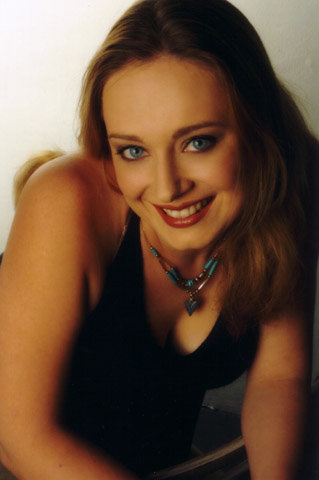 The
University of Cape Town informed Natanja Greeff today that her
application to do a Masters Degree at the department of Historical
Studies has been approved. Natanja will do a research degree about
the genealogy of the Greeff family, focusing on how the family
formed new geographical branches at the farms on which Greeff people
settled. Natanja's research proposal is attached below.
The
University of Cape Town informed Natanja Greeff today that her
application to do a Masters Degree at the department of Historical
Studies has been approved. Natanja will do a research degree about
the genealogy of the Greeff family, focusing on how the family
formed new geographical branches at the farms on which Greeff people
settled. Natanja's research proposal is attached below.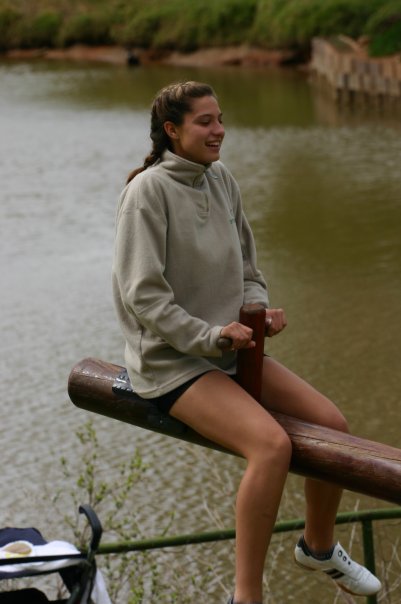 I studied
with a bursary from the government (Nuclear Energy Corporation). I
went to work at Pelindaba in 1986. There I dabbled with the refining
and purification of calcium (from aluminium powder and calcium
oxide). Pure calcium is one of the raw materials used to produce
uranium fluoride (how, I don’t know). I also worked on the
extraction of uranium oxide from water solutions using membranes.
This was so booooringgggggggg……… I realized that I am not a
research engineer at heart.
I studied
with a bursary from the government (Nuclear Energy Corporation). I
went to work at Pelindaba in 1986. There I dabbled with the refining
and purification of calcium (from aluminium powder and calcium
oxide). Pure calcium is one of the raw materials used to produce
uranium fluoride (how, I don’t know). I also worked on the
extraction of uranium oxide from water solutions using membranes.
This was so booooringgggggggg……… I realized that I am not a
research engineer at heart. During
my time at this company I worked myself out of 4 jobs. I would learn
what was required, implement the right procedures and behaviour in
my sub-ordinates, and then identify the brightest one and teach them
my job. I would delegate most of my work leaving me free to explore
other things. Then I would motivate my manager/s or executives to
promote me or officially free me up to pursue these interests. It
worked for me…..
During
my time at this company I worked myself out of 4 jobs. I would learn
what was required, implement the right procedures and behaviour in
my sub-ordinates, and then identify the brightest one and teach them
my job. I would delegate most of my work leaving me free to explore
other things. Then I would motivate my manager/s or executives to
promote me or officially free me up to pursue these interests. It
worked for me…..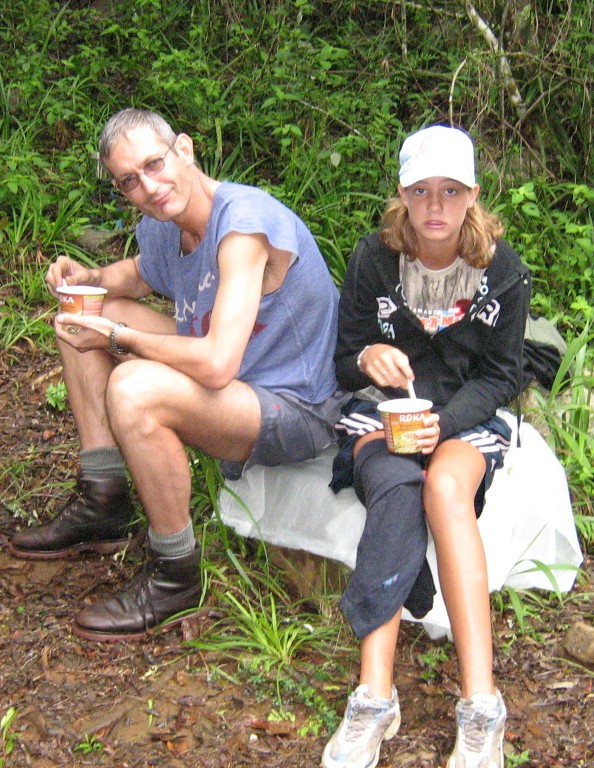 I was lucky,
after 6 months of scraping the bottom of the barrel, selling my
house, cancelling my policies and borrowing money from the family,
to be offered a job at Proudfoot consulting as a consultant. These 6
months of unemployment took me 6 years to make up. Anyone of you
that has been retrenched will know how I felt. Proudfoot immediately
sent me off to a mine in Carltonville. Drive there on a Monday
morning and see the family again on the Friday evening. Carltonville
did not have a big variety of places to eat, only one restaurant, a
pizza place and a Chicken Licken. I had no real cash, so I lived on
pizza and coffee at the guesthouse during the week. I would go into
the pizza place, wave to the girl behind the counter, sit in a booth
with my book and the waitress would bring my coffee and ask “same
again Mr Greeff?” Guess what the family wanted when I got home on a
Friday? You guessed it, pizza!! After 6 months of this I asked the
landlady of the guesthouse if I could eat with them, provided they
had vegetables. Luckily she agreed, else I might have died of
scurvy.
I was lucky,
after 6 months of scraping the bottom of the barrel, selling my
house, cancelling my policies and borrowing money from the family,
to be offered a job at Proudfoot consulting as a consultant. These 6
months of unemployment took me 6 years to make up. Anyone of you
that has been retrenched will know how I felt. Proudfoot immediately
sent me off to a mine in Carltonville. Drive there on a Monday
morning and see the family again on the Friday evening. Carltonville
did not have a big variety of places to eat, only one restaurant, a
pizza place and a Chicken Licken. I had no real cash, so I lived on
pizza and coffee at the guesthouse during the week. I would go into
the pizza place, wave to the girl behind the counter, sit in a booth
with my book and the waitress would bring my coffee and ask “same
again Mr Greeff?” Guess what the family wanted when I got home on a
Friday? You guessed it, pizza!! After 6 months of this I asked the
landlady of the guesthouse if I could eat with them, provided they
had vegetables. Luckily she agreed, else I might have died of
scurvy.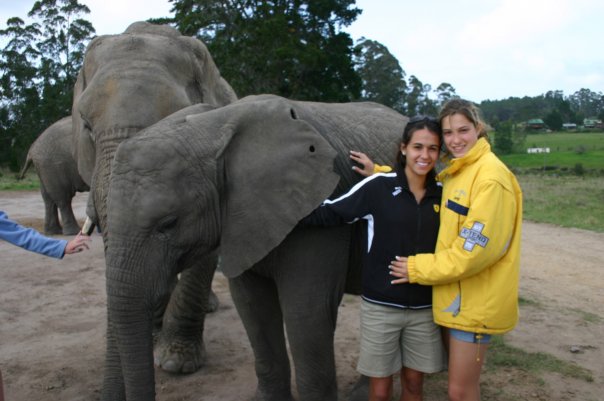 Francois
asked me to also write about the Greeff family I know about. That is
a big problem. I don’t know much about them to be truthful. As I
always had my nose in a book I did not get to know my father’s side
of the family. That, well as they all lived in Northern Transvaal
(now Limpopo) and Botswana. My father is a Thomas Gerhardus as was
his father before him. There is some confusion about what my
father’s grandfather was called. My Grandfather had three or four
brothers and I think the oldest one was a Jan Johannes, but my dad
is not sure. I asked him to try and find out from the living aunts.
Francois
asked me to also write about the Greeff family I know about. That is
a big problem. I don’t know much about them to be truthful. As I
always had my nose in a book I did not get to know my father’s side
of the family. That, well as they all lived in Northern Transvaal
(now Limpopo) and Botswana. My father is a Thomas Gerhardus as was
his father before him. There is some confusion about what my
father’s grandfather was called. My Grandfather had three or four
brothers and I think the oldest one was a Jan Johannes, but my dad
is not sure. I asked him to try and find out from the living aunts. 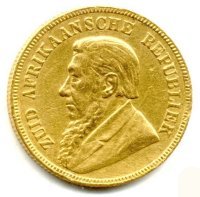 On my mother’s side the family can be traced back to Oom Paul
Kruger. My mother’s mother was a direct descendant from this great
man. My mother’s father was the grandson of the Erasmus that built
the “Spookhuis” or Erasmus castle in Pretoria. His mother was an
Erasmus but his father a Pienaar. He was Pine Pienaar, a life-long
member of the old Berea club in Pretoria. We often went there in its
golden days as I remember. Sunday afternoon after church, eating
from one till about four (I WAS a growing boy you know!). Those were
the good times.
On my mother’s side the family can be traced back to Oom Paul
Kruger. My mother’s mother was a direct descendant from this great
man. My mother’s father was the grandson of the Erasmus that built
the “Spookhuis” or Erasmus castle in Pretoria. His mother was an
Erasmus but his father a Pienaar. He was Pine Pienaar, a life-long
member of the old Berea club in Pretoria. We often went there in its
golden days as I remember. Sunday afternoon after church, eating
from one till about four (I WAS a growing boy you know!). Those were
the good times.